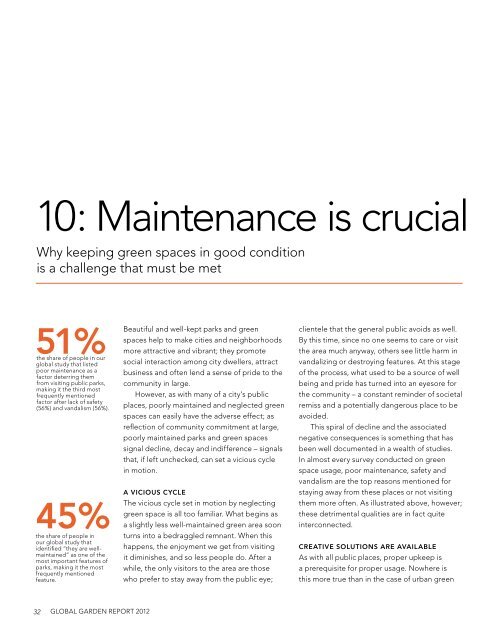GLOBAL GARDEN REPORT 2012 - Husqvarna Group
GLOBAL GARDEN REPORT 2012 - Husqvarna Group
GLOBAL GARDEN REPORT 2012 - Husqvarna Group
Create successful ePaper yourself
Turn your PDF publications into a flip-book with our unique Google optimized e-Paper software.
10: Maintenance is crucial<br />
Why keeping green spaces in good condition<br />
is a challenge that must be met<br />
51%<br />
the share of people in our<br />
global study that listed<br />
poor maintenance as a<br />
factor deterring them<br />
from visiting public parks,<br />
making it the third most<br />
frequently mentioned<br />
factor after lack of safety<br />
(56%) and vandalism (56%).<br />
45%<br />
the share of people in<br />
our global study that<br />
identified “they are wellmaintained”<br />
as one of the<br />
most important features of<br />
parks, making it the most<br />
frequently mentioned<br />
feature.<br />
32 <strong>GLOBAL</strong> <strong>GARDEN</strong> <strong>REPORT</strong> <strong>2012</strong><br />
Beautiful and well-kept parks and green<br />
spaces help to make cities and neighborhoods<br />
more attractive and vibrant; they promote<br />
social interaction among city dwellers, attract<br />
business and often lend a sense of pride to the<br />
community in large.<br />
However, as with many of a city’s public<br />
places, poorly maintained and neglected green<br />
spaces can easily have the adverse effect; as<br />
reflection of community commitment at large,<br />
poorly maintained parks and green spaces<br />
signal decline, decay and indifference – signals<br />
that, if left unchecked, can set a vicious cycle<br />
in motion.<br />
A VICIOUS CYCLE<br />
The vicious cycle set in motion by neglecting<br />
green space is all too familiar. What begins as<br />
a slightly less well-maintained green area soon<br />
turns into a bedraggled remnant. When this<br />
happens, the enjoyment we get from visiting<br />
it diminishes, and so less people do. After a<br />
while, the only visitors to the area are those<br />
who prefer to stay away from the public eye;<br />
clientele that the general public avoids as well.<br />
By this time, since no one seems to care or visit<br />
the area much anyway, others see little harm in<br />
vandalizing or destroying features. At this stage<br />
of the process, what used to be a source of well<br />
being and pride has turned into an eyesore for<br />
the community – a constant reminder of societal<br />
remiss and a potentially dangerous place to be<br />
avoided.<br />
This spiral of decline and the associated<br />
negative consequences is something that has<br />
been well documented in a wealth of studies.<br />
In almost every survey conducted on green<br />
space usage, poor maintenance, safety and<br />
vandalism are the top reasons mentioned for<br />
staying away from these places or not visiting<br />
them more often. As illustrated above, however;<br />
these detrimental qualities are in fact quite<br />
interconnected.<br />
CREATIVE SOLUTIONS ARE AVAILABLE<br />
As with all public places, proper upkeep is<br />
a prerequisite for proper usage. Nowhere is<br />
this more true than in the case of urban green

















